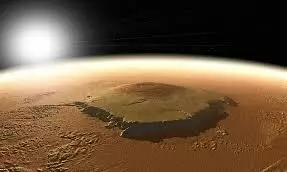
Scientists find hidden structures beneath Mars' surface, sheds light on volcanic activity
text_fieldsA groundbreaking study has uncovered vast, hidden structures beneath Mars' surface, suggesting that the planet's mantle may still be active and contributing to the growth of Olympus Mons, the largest volcano in the solar system.
The discovery was made by analyzing Mars' gravity field through data collected from multiple space missions and advanced modeling, according to a report in Science Alert.
Bart Root from Delft University of Technology (TU Delft) shared the findings at the Europlanet Science Congress (EPSC) in Berlin. His team revealed that these massive, dense structures, which may be volcanic in origin or remnants of ancient impacts, are located beneath the northern hemisphere of Mars. One of the features even resembles the shape of a dog. These formations are not visible at the surface but were detected through gravity data, offering scientists a glimpse into Mars' ancient geological history.
The research team employed an innovative method by studying tiny deviations in satellite orbits to investigate the gravity field and mass distribution beneath Mars' surface. Their findings were integrated with new data from NASA's InSight mission, providing fresh insights into the planet’s crust and mantle dynamics.
The study also uncovered a vast, lightweight structure, approximately 1,750 kilometers wide, located 1,100 kilometers below the surface of the Tharsis Rise region, which is home to Olympus Mons. This structure is believed to be pushing the region upward, indicating that Mars might still be experiencing internal movements.
Dr. Root highlighted that the new data from NASA's InSight mission has reshaped scientists' understanding of how Olympus Mons and its surrounding areas are supported. The study suggests that Mars could still be undergoing active volcanic processes, possibly leading to the creation of new surface features.
While no currently active volcanoes have been observed on Mars, the research indicates that volcanic resurfacing in the Tharsis region occurred more recently than previously thought, suggesting that Mars may have been volcanically active in the planet's recent geological past.























